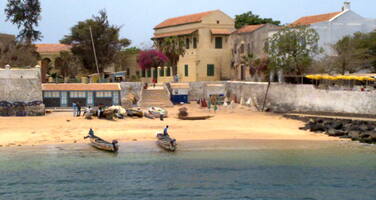Island of Gorée
Factors affecting the property in 1990*
- Erosion and siltation/ deposition
- Identity, social cohesion, changes in local population and community
- Other Threats:
Dilapidated state of some buildings
International Assistance: requests for the property until 1990
Total amount approved : 73,700 USD
| 1981 | Technical assistance for the renovation of the Island ... (Approved) | 40,700 USD |
| 1981 | Equipment and financial assistance for the Island of ... (Approved) | 33,000 USD |
Missions to the property until 1990**
Conservation issues presented to the World Heritage Committee in 1990
This site placed on the World Heritage List in 1978 under criterion (vi) has since December 1980 been the subject of an international safeguarding campaign following an appeal made to the international community by the Director-General of Unesco.
In 1981 a master plan for the safeguarding operations, setting out the operating criteria for the restoration of the buildings, both public and private, and providing for their functional rehabilitation and for the necessary road works, was adopted.
Accordingly, since the site's inclusion in the List, restoration work has been carried out on several buildings with the help of national, bilateral or multilateral funding.
It is to be noted that of the 10 buildings originally singled out for restoration work in the action plan for the international campaign, only four of them have benefited from work financed by the State or through bilateral arrangements: the House of Sudan, on which the work, financed by the Federal Republic of Germany, is completed; the Captaincy, not yet completed (financed by the Republic of Korea); the 'Victoria Albis' House and the ruins of the 'Diouga Dieng' House have been partly restored or strengthened through national funding. The six other buildings included in the action plan are either in a state of Ruin or overpopulated and have not been able to benefit from the functional rehabilitation that had therefore been envisaged:
| Function assigned | State | ||
|
(1) |
J. Basse House |
Annex exhibition gallery |
In ruins |
|
(2) |
Hortala House |
Nursery |
In ruins |
|
(3) |
Former Andrand House |
Open-air theatre |
In ruins |
|
(4) |
Former William Ponty School |
Cultural centre |
Occupied by families of ex-civil servants - |
|
|
|
|
120 persons |
|
(5) |
Former convent school |
Public library |
Occupied by families of ex-civil servants |
|
(6) |
Former nuns' home |
Artists' studios |
Occupied by families - |
|
|
|
|
50 persons |
However, irrespective of the action plan for the campaign, many other buildings have been restored and assigned for use by educational and cultural institutions.
The Fort d'Estrees has received financing from Lebanon and houses the history museum. The Slave House, responsibility for which has been assumed by the foundation Gorée/Fraternité, although still being converted and restored, also houses a museum, which is devoted to the slave trade. The Museum of the Sea, financed by France, has been closed for four years. The Université des Mutants, installed in a building restored by Senegal, is currently being used as a conference centre. The Maison du Marin (The Seaman's House), financed by France, is used for stop-overs by the French Navy. A dispensary has been installed in an old building thanks to joint funding from the Sovereign Order of Malta and Italy, and the Mosque has been restored with the help of the Aga Khan Foundation. The beach Battery has been restored with national funds and converted into a market. The Senegalese Government has also financed restoration work on the buildings housing the police station, the local school, the Lion school, the customs office and the fire station, installed in the former town hall. Harbour development operations, public lighting and highway amenities have benefited from a loan from the World Bank.
An important feature of the island, the 'Western Battery', received emergency assistance amounting to $33,000 from the World Heritage Fund in 1981. The concern at the time was to consolidate the Battery and the ramparts which were in danger of falling in, having been very affected by the violence of the sea in that part of the island. Despite the work done, these structures are again very much under threat, some parts having already given way. The recent action plan survey has highlighted the poor state of the Manor House (the 'Castel'), which is frequently visited by tourists but has become dangerous.
Assistance amounting to $19,600 has also been granted from the Fund to help in the training of technicians responsible for rehabilitating the island.
Work on the buildings still to be restored cannot be envisaged however, without the problem of their subsequent use being settled beforehand. Several of them currently house a large number of families living on the island.
Summary of the interventions
Decisions adopted by the Committee in 1990
No draft Decision
* :
The threats indicated are listed in alphabetical order; their order does not constitute a classification according to the importance of their impact on the property.
Furthermore, they are presented irrespective of the type of threat faced by the property, i.e. with specific and proven imminent danger (“ascertained danger”) or with threats which could have deleterious effects on the property’s Outstanding Universal Value (“potential danger”).
** : All mission reports are not always available electronically.


